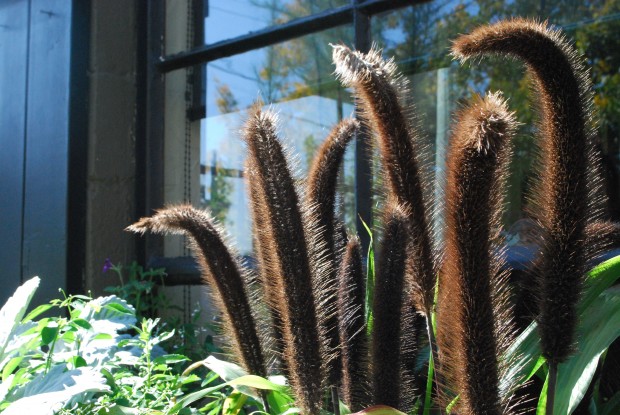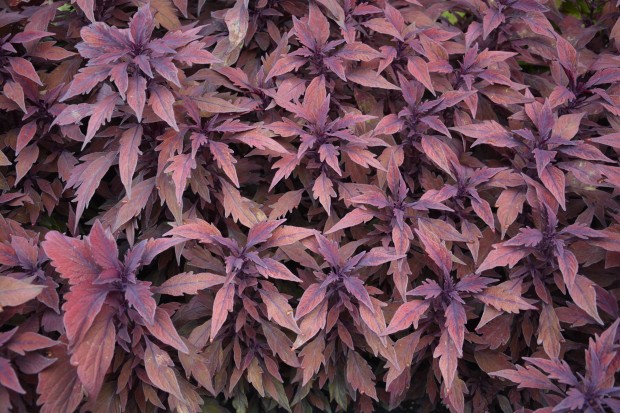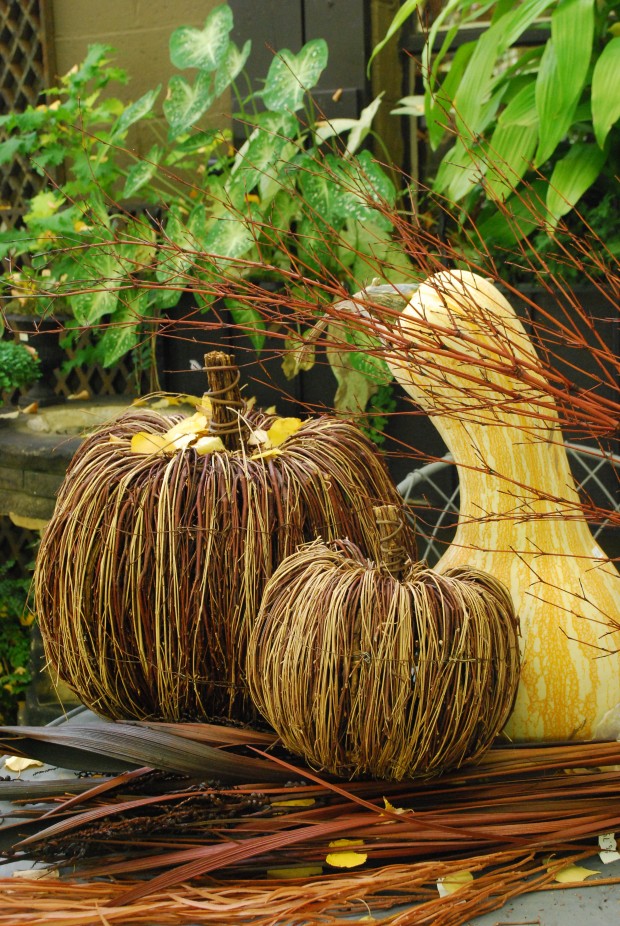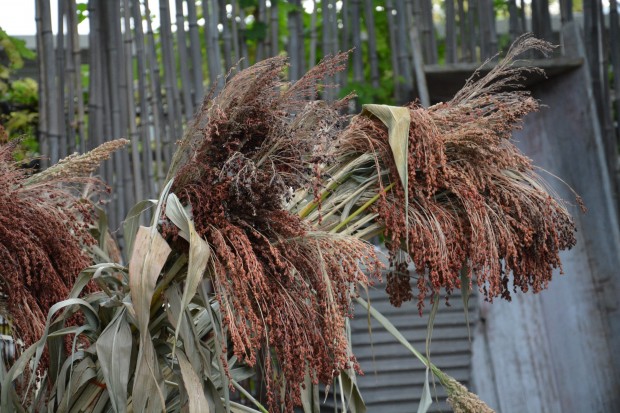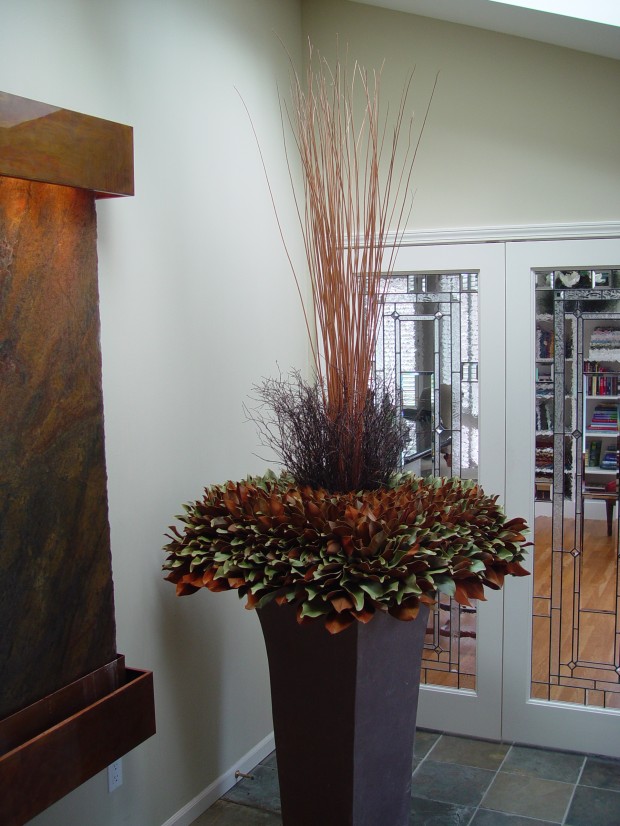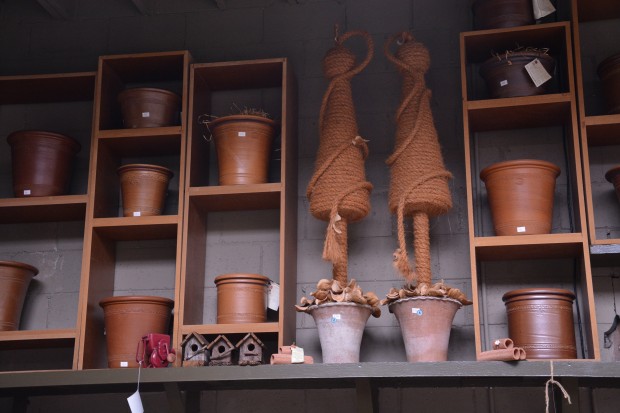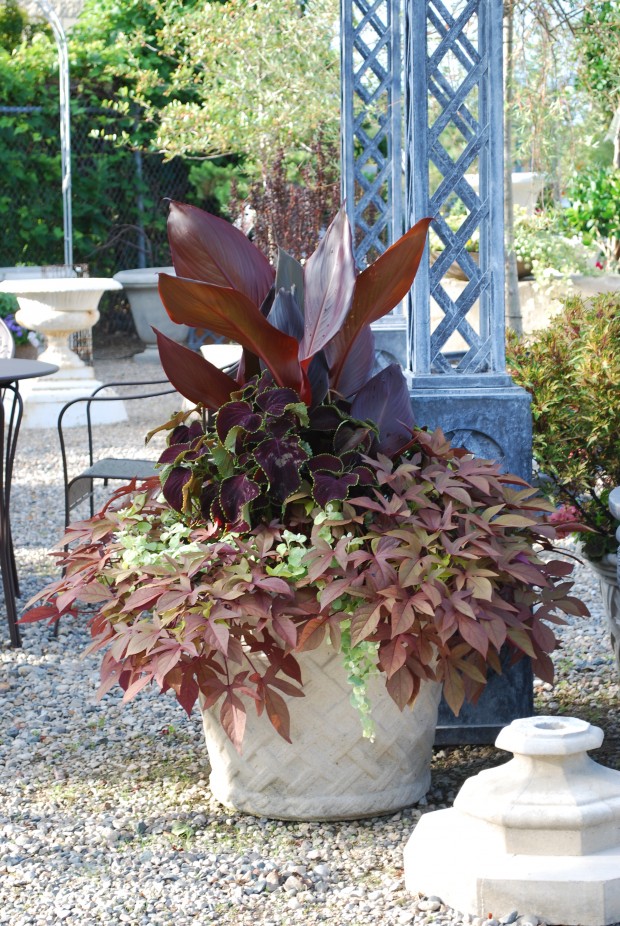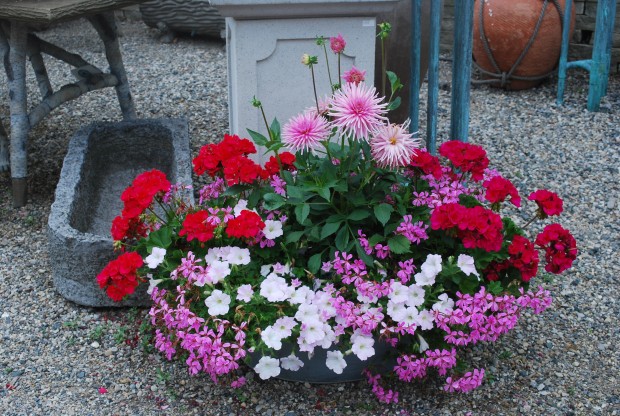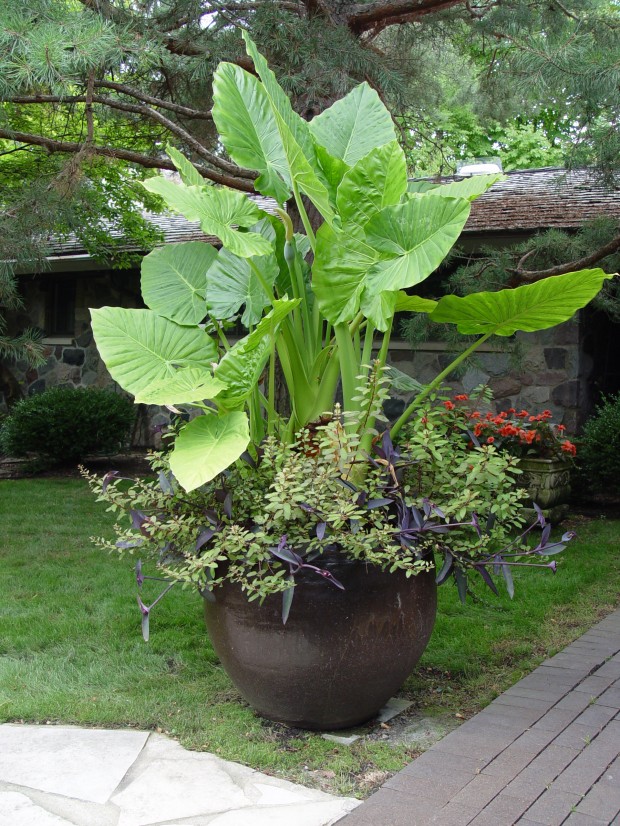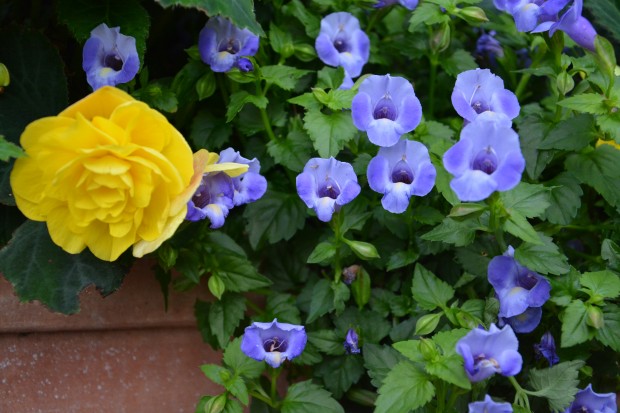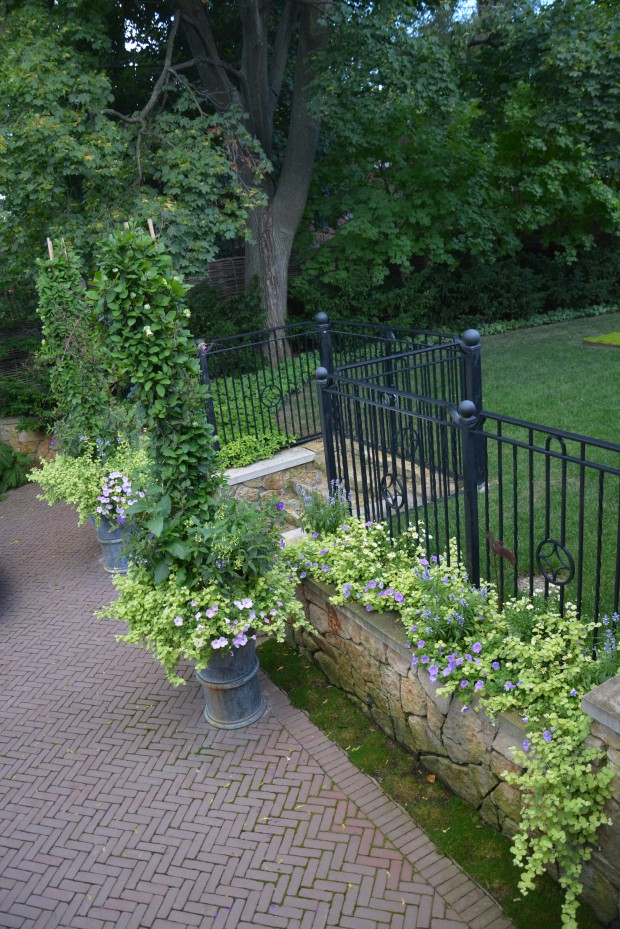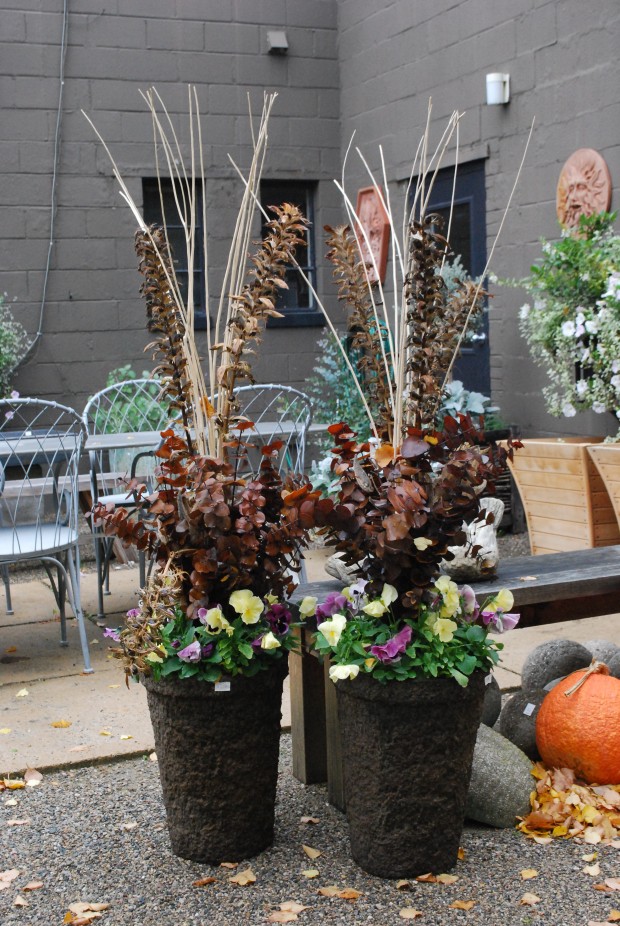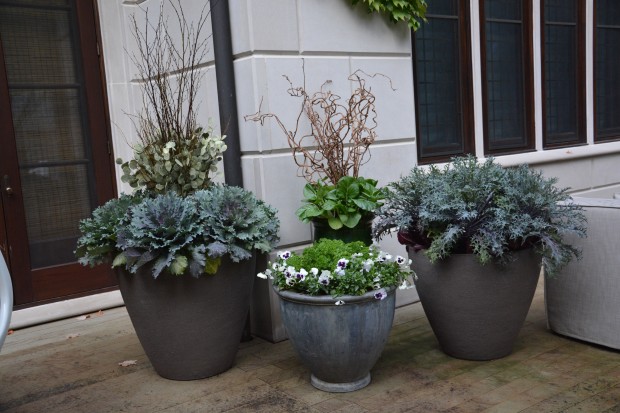At A Glance: Brown
Generous
 Though we have had some very warm weather lately, our the fall gardening season has begun. There are telltale signs. Shorter days, a decidedly cooler quality of light, and the the chilly mornings are all signs that summer is coming to a close. But the end of summer is by no means the end of the garden. The abundance that results in the harvest season is one of fall’s great pleasures.
Though we have had some very warm weather lately, our the fall gardening season has begun. There are telltale signs. Shorter days, a decidedly cooler quality of light, and the the chilly mornings are all signs that summer is coming to a close. But the end of summer is by no means the end of the garden. The abundance that results in the harvest season is one of fall’s great pleasures.
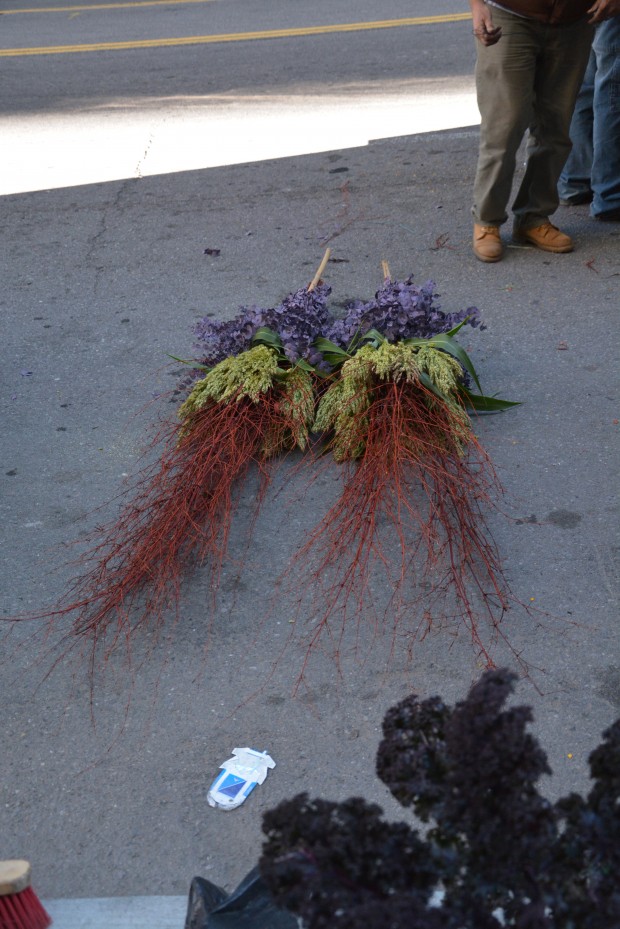 The grasses are maturing. Our farmer’s market is overflowing with squashes, greens of all kinds, pumpkins, cabbage and broccoli, gourds and tomatoes. Many vegetables need our entire season to mature. Locally grown fruit of all kinds-especially apples-are available at market. Similarly, there are lots of beautiful materials available to the avid container gardener. I like for the fall containers we do to have a generous and abundant quality to them. A fall centerpiece for a container is usually comprised of harvested goods. Millet, dry twigs, broom corn, eucalyptus, milkweed pods and dried perennial stems are all natural materials in a harvested state.
The grasses are maturing. Our farmer’s market is overflowing with squashes, greens of all kinds, pumpkins, cabbage and broccoli, gourds and tomatoes. Many vegetables need our entire season to mature. Locally grown fruit of all kinds-especially apples-are available at market. Similarly, there are lots of beautiful materials available to the avid container gardener. I like for the fall containers we do to have a generous and abundant quality to them. A fall centerpiece for a container is usually comprised of harvested goods. Millet, dry twigs, broom corn, eucalyptus, milkweed pods and dried perennial stems are all natural materials in a harvested state.
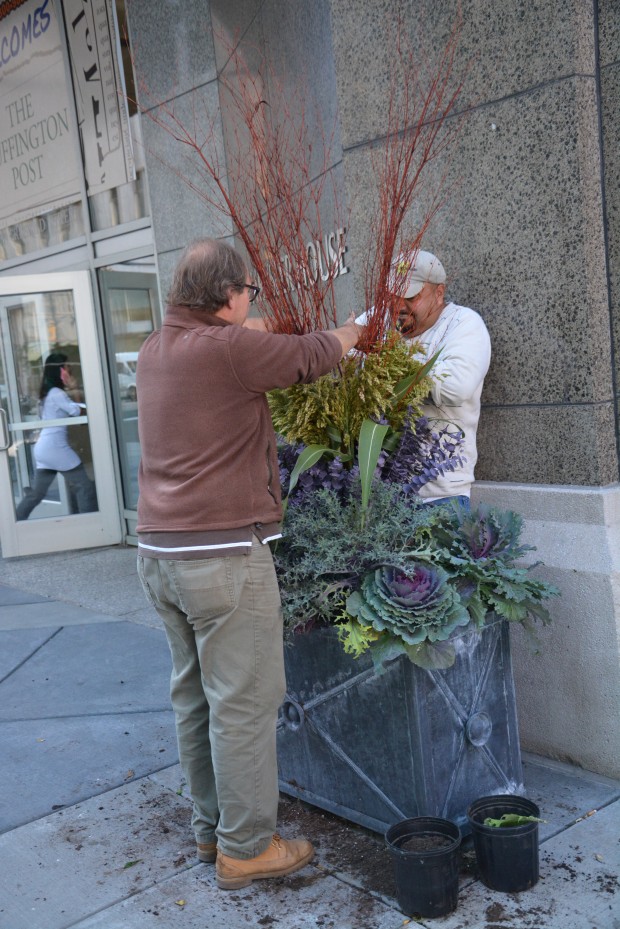 When the temperatures begin to drop, there is not so much growing going on. We rely on large material to give containers the scale they need right from the start. The centerpieces have large stout bamboo stakes at their center. These stakes go deep into the soil, keeping a big heavy centerpiece not only aloft, but straight up and down.
When the temperatures begin to drop, there is not so much growing going on. We rely on large material to give containers the scale they need right from the start. The centerpieces have large stout bamboo stakes at their center. These stakes go deep into the soil, keeping a big heavy centerpiece not only aloft, but straight up and down.
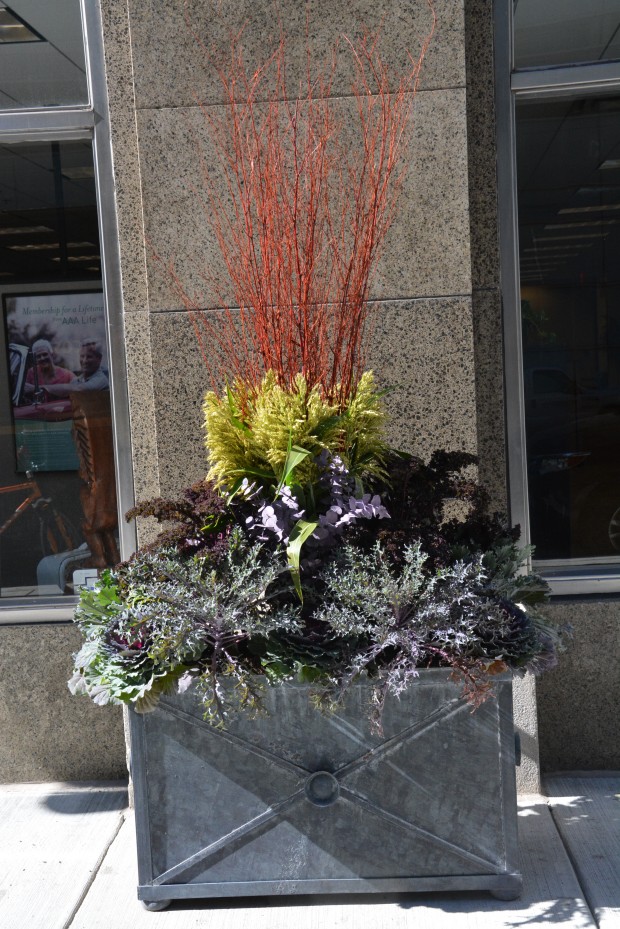 The cabbages and kale are the mainstays of our fall plantings. We are indeed fortunate to have growers that supply them in one gallon pots this time of year. A container this size represented in a generous way makes a visually pleasing statement.
The cabbages and kale are the mainstays of our fall plantings. We are indeed fortunate to have growers that supply them in one gallon pots this time of year. A container this size represented in a generous way makes a visually pleasing statement.
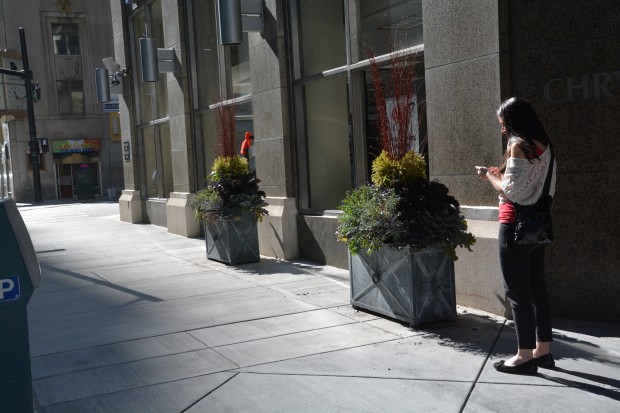 This material will persist and look good long into the fall. The cabbage and kale will shrug off the frosts in November as if they were nothing more than an annoyance. The dry and preserved material is very happy outdoors in cool weather with great air circulation. All it takes is a willingness to scoop up what materials are available that interest you, and make something of them.
This material will persist and look good long into the fall. The cabbage and kale will shrug off the frosts in November as if they were nothing more than an annoyance. The dry and preserved material is very happy outdoors in cool weather with great air circulation. All it takes is a willingness to scoop up what materials are available that interest you, and make something of them.
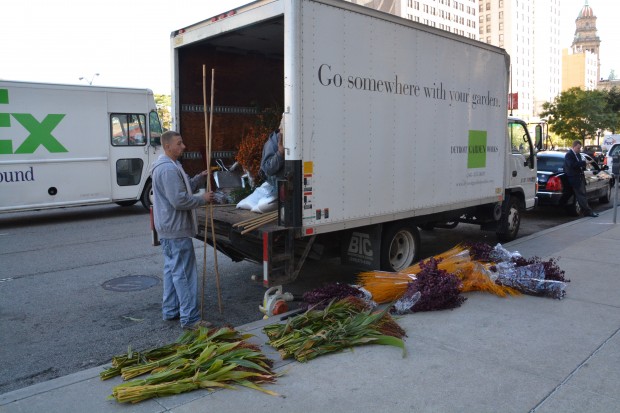 This Friday past we planted 24 pots in downtown Detroit-we will finish up the last 7 on Monday. Assembling the materials for a planting takes a lot of time and planning, especially if the pots are large. My group has worked together long enough to have established a working routine.
This Friday past we planted 24 pots in downtown Detroit-we will finish up the last 7 on Monday. Assembling the materials for a planting takes a lot of time and planning, especially if the pots are large. My group has worked together long enough to have established a working routine.
 Ahead of the planting, the pots need to be designed. Once I put that on paper, Steve will coordinate the installation. Everyone has a job such that the work can be completed with dispatch. All of the summer material needs to be removed and put on the truck; that material will be added to our compost piles. The new material is sorted, and distributed where it needs to go. Assembling centerpieces on site take 2 pair of hands. We try to clean up as we go, to keep the mess at a minimum.
Ahead of the planting, the pots need to be designed. Once I put that on paper, Steve will coordinate the installation. Everyone has a job such that the work can be completed with dispatch. All of the summer material needs to be removed and put on the truck; that material will be added to our compost piles. The new material is sorted, and distributed where it needs to go. Assembling centerpieces on site take 2 pair of hands. We try to clean up as we go, to keep the mess at a minimum.
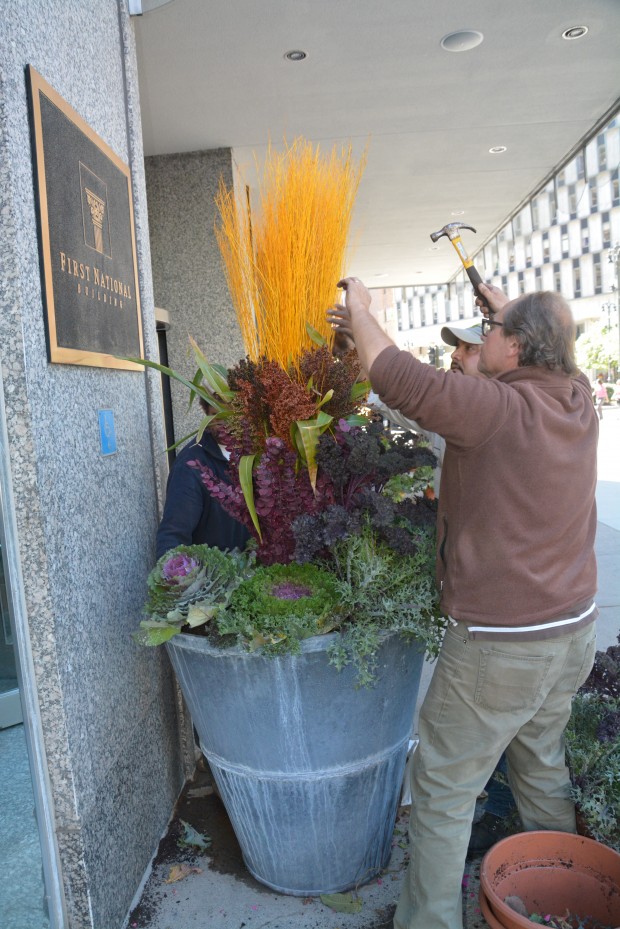 The centerpiece goes in last, and is firmly secured. The construction of fall pots is entirely unlike planting pots for summer, and more like planting pots for winter. There is more arranging going on than growing.
The centerpiece goes in last, and is firmly secured. The construction of fall pots is entirely unlike planting pots for summer, and more like planting pots for winter. There is more arranging going on than growing.
 Bittersweet stems are zip tied to bamboo stakes, and set in the pot at the very last. Bittersweet is not a plant I would want in my garden-it is highly invasive. However the dried stems and berries are very durable and beautiful outdoors in fall pots.
Bittersweet stems are zip tied to bamboo stakes, and set in the pot at the very last. Bittersweet is not a plant I would want in my garden-it is highly invasive. However the dried stems and berries are very durable and beautiful outdoors in fall pots.
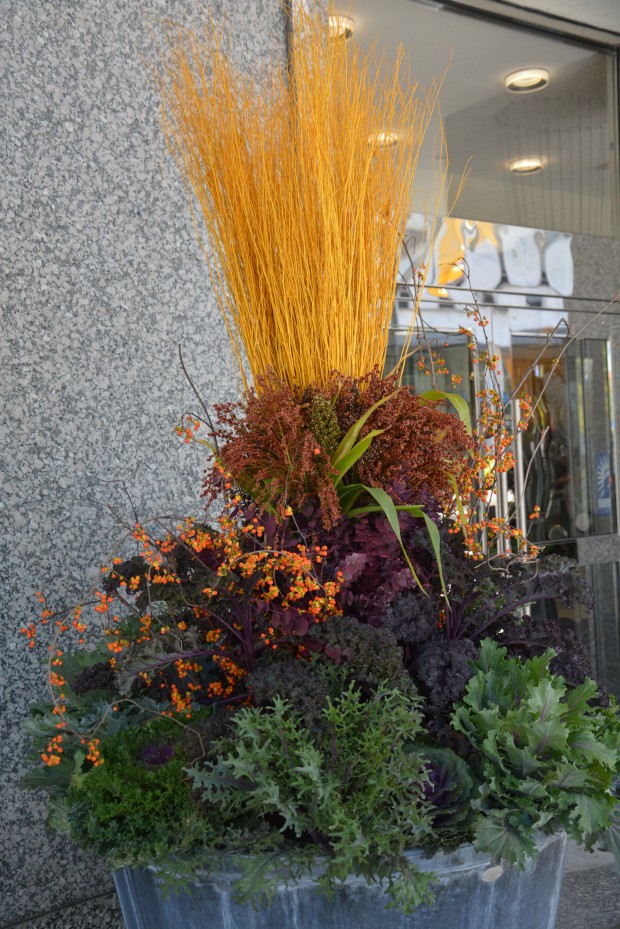 The dried and dyed yellow twigs provide lots of color at a time of year when color is at a premium. Preserved eucalyptus is another great source of color. The plum eucalyptus in this arrangement is subtle, but it picks up the dark carmine pink of the cabbage and kale.
The dried and dyed yellow twigs provide lots of color at a time of year when color is at a premium. Preserved eucalyptus is another great source of color. The plum eucalyptus in this arrangement is subtle, but it picks up the dark carmine pink of the cabbage and kale.
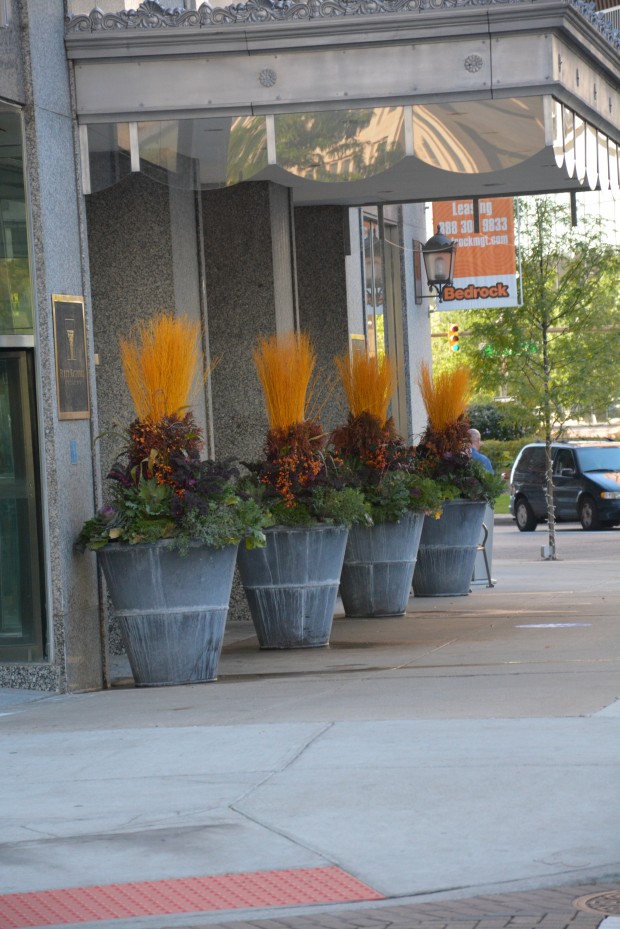 I like fall represented as a celebration.
I like fall represented as a celebration.
Pansies and violas are great in small pots, or as a accent in a large pots. These bowls are 6 feet in diameter, and take a lot of material. The contemporary shape benefits from the repetition of materials. Each of the 11 pots we planted for fall has the same overall design, but features different and alternating materials.
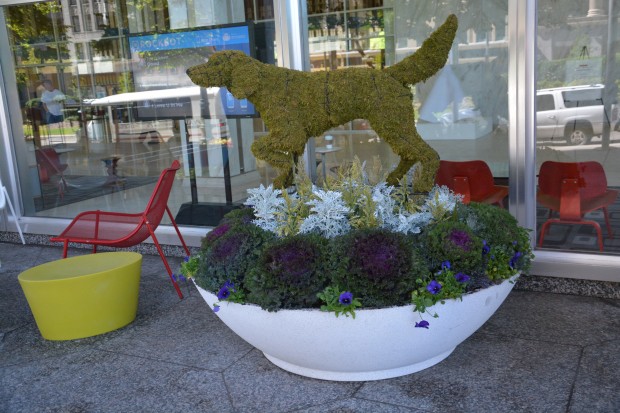 The fall planting for all of the dogs at Chase Tower have a center of dusty miller and cut green millet. The silver and light green help the dark moss sculptures to stand out. The pots are located under a very high overhang, so they are always in the shade. The cabbage and kale will tolerate this for the several months they will be planted here.
The fall planting for all of the dogs at Chase Tower have a center of dusty miller and cut green millet. The silver and light green help the dark moss sculptures to stand out. The pots are located under a very high overhang, so they are always in the shade. The cabbage and kale will tolerate this for the several months they will be planted here.
 The moss dogs add so much visual interest, and they can be retained season after season. The moss can be be sprayed with moss food coloring once it fades. When the time comes that the moss deteriorates, the steel frames can be re stuffed.
The moss dogs add so much visual interest, and they can be retained season after season. The moss can be be sprayed with moss food coloring once it fades. When the time comes that the moss deteriorates, the steel frames can be re stuffed.
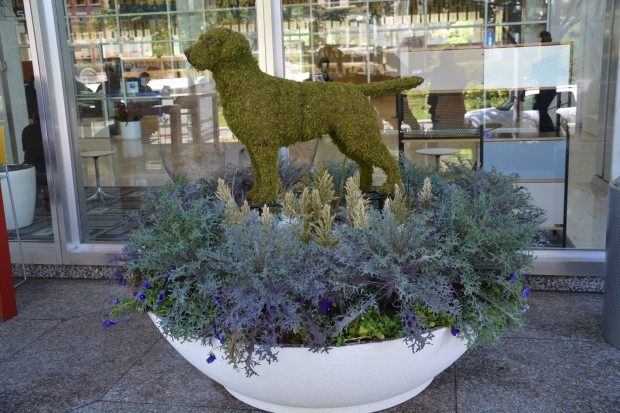 Thre dogs themselves are welded onto steel posts that are 30″ tall. This keeps the sculptures above the top of the plant material.
Thre dogs themselves are welded onto steel posts that are 30″ tall. This keeps the sculptures above the top of the plant material.
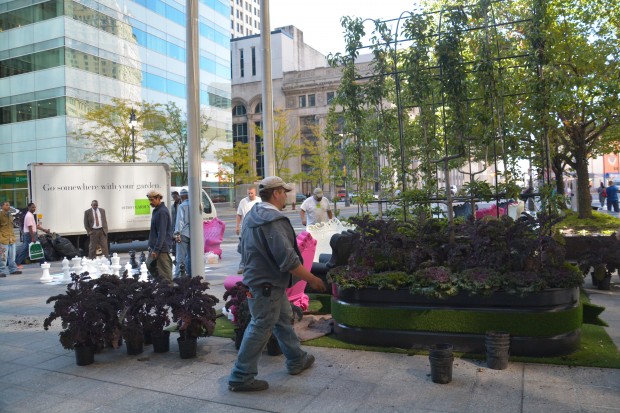 Our last stop-the stock tanks at 1001 Woodward. The espalier pear trees will spend the fall season here, and then be moved into storage for the winter. The redbor kale and frilly purple cabbage look great with the black tanks.
Our last stop-the stock tanks at 1001 Woodward. The espalier pear trees will spend the fall season here, and then be moved into storage for the winter. The redbor kale and frilly purple cabbage look great with the black tanks.
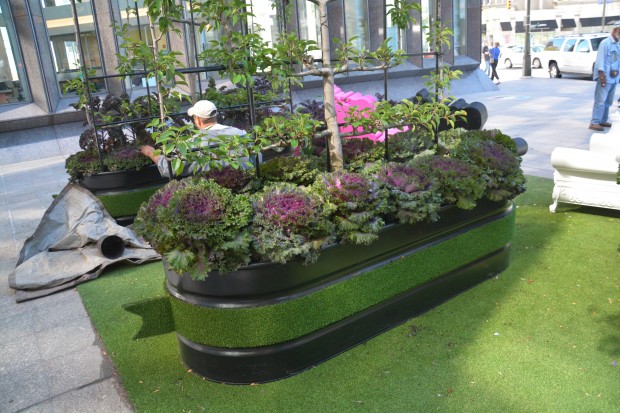
This small urban park is as friendly as it is stylish. The stock tanks are an unexpected choice for containers. The artificial turf is just plain fun. It was a gorgeous day to be downtown planting.
A Case For Planting Containers For Fall
Our summer season has not been so friendly to those of us who garden in containers. All of the tropical plants in the containers despised the cold, and the relentless rain. Why do I even plant tropical plants in my containers? Annual plants bloom, set seed, and die, over the course of one season. If I remove the dead flower from an annual plant, I am thwarting its natural instinct to reproduce itself via the act of setting seed. This annual plant will bloom again, hoping to set seed, the next time. This means there are flowers coming on all season long. Some hybrid annual plants are sterile-they do not set seed. They will continue to bloom over the warm months in spite of this.
Warm months is the operative phrase here. Many of our common annual plants are native to climates much warmer than the midwest. They dislike being planted in cold soil in our spring, and they faint dead away with the first frost. Why do I put up with this? I like that group of annual flowers that grow larger and bloom with abandon all summer long. Those plants with oversized tropical leaves-as in alocasias, calocasias, cannas, tree ferns and the like-are equally as pleasing. They represent lush in a way that few plants hardy in my zone can match. Container plantings help make my landscape feel like summer.
I admire those gardeners that plant hostas in pots-bravo. However, I like my hostas best, in ground. I have tried lots of perennial and shrubby plants in containers-by this I mean lavender, hydrangeas, hyssop, buddleia, gloriosa daisies, boxwood-I could go on, but won’t. The only perennial plant I really value in containers is strawberries. The leaves are large and beautifully serrated. The unripe fruit is a beautiful color. The ripe fruit is irresistible. Some gardeners are attracted to the idea that their containers full of hostas could be brought out of the garage in the spring, and put in place-as usual. Other gardeners are determined to keep boxwood, boxwood topiaries, junipers and their topiary variants alive in containers, season after season, year after year. One of the things I value the most about the planting seasonal containers is how a fresh start energetically engages the imagination. Last year’s containers-more about history than the moment. I am not enchanted by my containers being over and done with. Done-I dread both the adjective, and the noun. So does nature, by the way.
The prospect of my containers being filled with the same plants year after year would bore me beyond all belief. I would not care if the boxwood sphere put on another six inches in height and girth. I value the change up pitch better than a fast ball down the middle. My landscape has taken many years to bring to a level that pleases me. Any major change would be a major upheaval. Not that I adverse to some upheaval. A landscape is a big fluid situation that evolves over a period of years. There is no fast forward. No matter how loud you are able to snap your fingers, the landscape will take years to really respond. But my summer containers reward my efforts relatively quickly.
The second reason I so value tropical plants in my containers? I can plant something different next year, and the year after that. I can ditch my failures, and move on. I can entertain a color scheme on a whim. A cold and rainy season will not stalk me beyond the frost. Next year will be different.
As for planting fall pots-let’s agree that this summer was not the best for container plantings. I have appreciated the summer heat we have gotten in September-all of my containers look much better than they did a month ago. Most of my containers have dark empty spots. Those holes are from the begonias that rotted. What coleus didn’t give up has spots-the tell tale sign of cold.
In late September, there are several options for a container that has unnattractive gaps. Those tropical plants that have faded away can be replaced with cold hardy plants-as in parsley, 4″ cabbage and kale, pansies, bok choy, Napa lettuce, ivy of every description, chrysanthemums, asters-there are no end of fall hardy and fall blooming plants that could fill your gaps.
Or you could replant you containers for fall. I have lots of containers. I will stand pat with most of them until the frost takes them down. But the pots I drive up to every day, I replant them for fall. I have lots of choices for material. Broom corn, fresh and preserved eucalyptus, twigs, preserved leptospermum, asters, gourds, dried grasses, cabbage, kale, lettuce, pansies, rosemary, thistles, pumpkins, bittersweet, dried hydrangeas from my yard, twigs from the field, chrysanthemums-you get my drift. It is entirely possible that my fall containers will be the best of the year. I have no regrets about the annuals going down. I have the fall season coming on.
All my driveway pots need is for me to assemble a group of fall materials, and soldier on. Soldiering on? This means plant. Stick. Arrange.
At A Glance: Putting One’s Best Foot Forward
 In the world of garden ornament, a container which sits on a foot is known as an urn. A foot? The rare hand carved French urns pictured above have feet. The foot is that piece which holds the body of the pot aloft. Off the ground. Imagine these pots sitting in a garden without the graceful and underscaled bases which serve no other purpose than to provide lift. An urn is any garden pot or container which includes a foot. Those of you who would have no interest in urns like this in your garden, stay with me, and hear me out.
In the world of garden ornament, a container which sits on a foot is known as an urn. A foot? The rare hand carved French urns pictured above have feet. The foot is that piece which holds the body of the pot aloft. Off the ground. Imagine these pots sitting in a garden without the graceful and underscaled bases which serve no other purpose than to provide lift. An urn is any garden pot or container which includes a foot. Those of you who would have no interest in urns like this in your garden, stay with me, and hear me out.
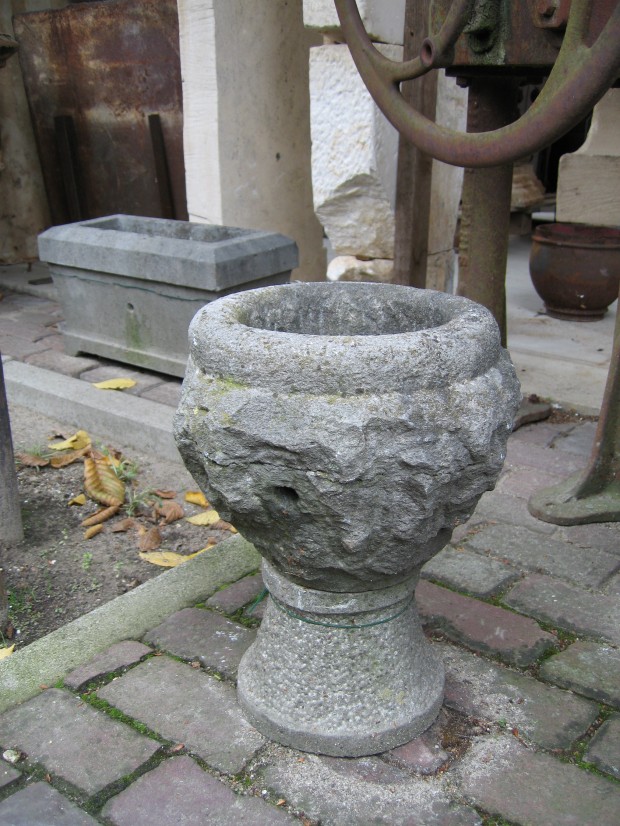 Even the most simple pot may benefit from a foot that distinguishes it, or raises it above the ground plane. If you plant bushel baskets, galvanized pails, vintage terra cotta drain tiles, contemporary concrete bowls or old bulb crates, the appearance of every garden container is improved by a foot of some sort. How so? Containers with large bottoms that sit down flat on a terrace surface might have a problem draining. Good drainage is essential for container gardening. There are lots of ways to raise a bushel basket off the ground-search out the possibilities.
Even the most simple pot may benefit from a foot that distinguishes it, or raises it above the ground plane. If you plant bushel baskets, galvanized pails, vintage terra cotta drain tiles, contemporary concrete bowls or old bulb crates, the appearance of every garden container is improved by a foot of some sort. How so? Containers with large bottoms that sit down flat on a terrace surface might have a problem draining. Good drainage is essential for container gardening. There are lots of ways to raise a bushel basket off the ground-search out the possibilities.
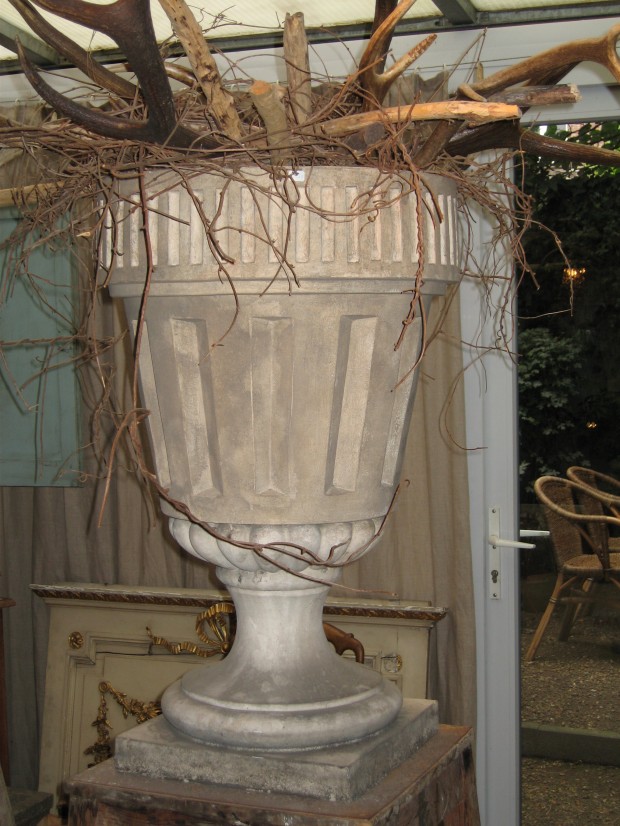 A big bottomed pot that sits down too wide and too hard on a flat surface can look down right frumpy. Imagine this vintage English stoneware urn without its foot. The curved squash like form of the top of this foot provides a graceful place for the top of this container to rest. Note that the body of the pot is separate from the foot. Minus the foot, this pot would look like it was suffering from the ill effects of gravity.
A big bottomed pot that sits down too wide and too hard on a flat surface can look down right frumpy. Imagine this vintage English stoneware urn without its foot. The curved squash like form of the top of this foot provides a graceful place for the top of this container to rest. Note that the body of the pot is separate from the foot. Minus the foot, this pot would look like it was suffering from the ill effects of gravity.
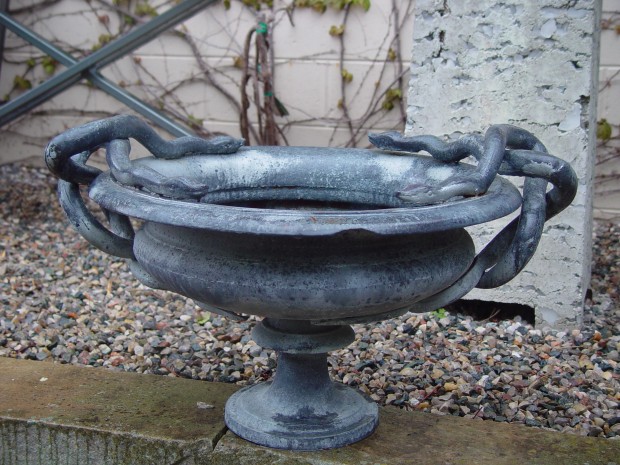 Feet make it possible for people to walk. A foot note can explain in great detail a paragraph of text. When my feet hurt, I hurt all over. Where am I going with this? A good foot on a container may provide your container plantings with a leg up. Feet are really important-no matter the venue.
Feet make it possible for people to walk. A foot note can explain in great detail a paragraph of text. When my feet hurt, I hurt all over. Where am I going with this? A good foot on a container may provide your container plantings with a leg up. Feet are really important-no matter the venue.
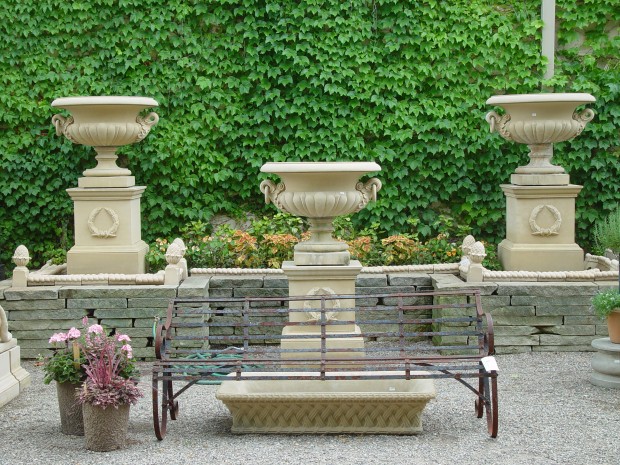 a trio of garden urns and pedestals from the David Sharp Studio in England
a trio of garden urns and pedestals from the David Sharp Studio in England
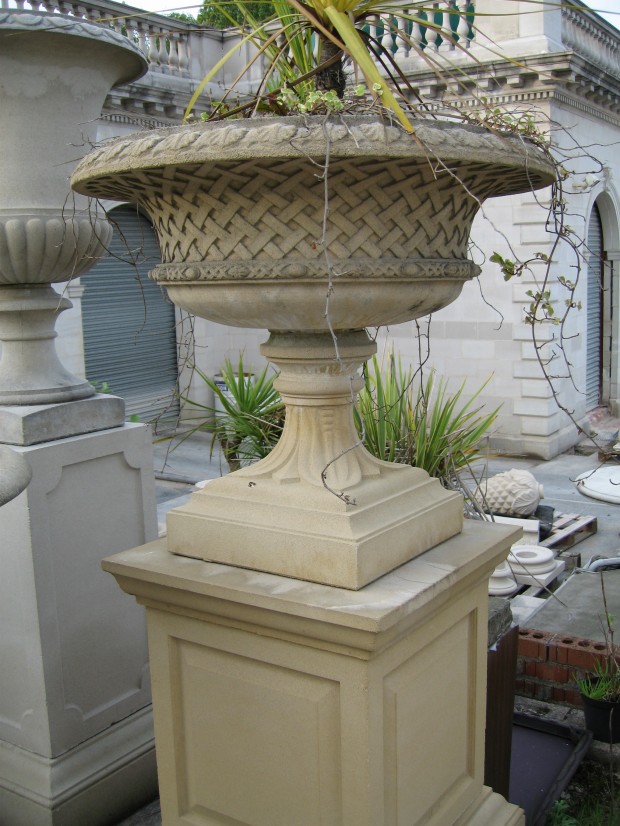 footed limestone basket weave urn
footed limestone basket weave urn
 Antique English limestone urns with attendant pedestals
Antique English limestone urns with attendant pedestals
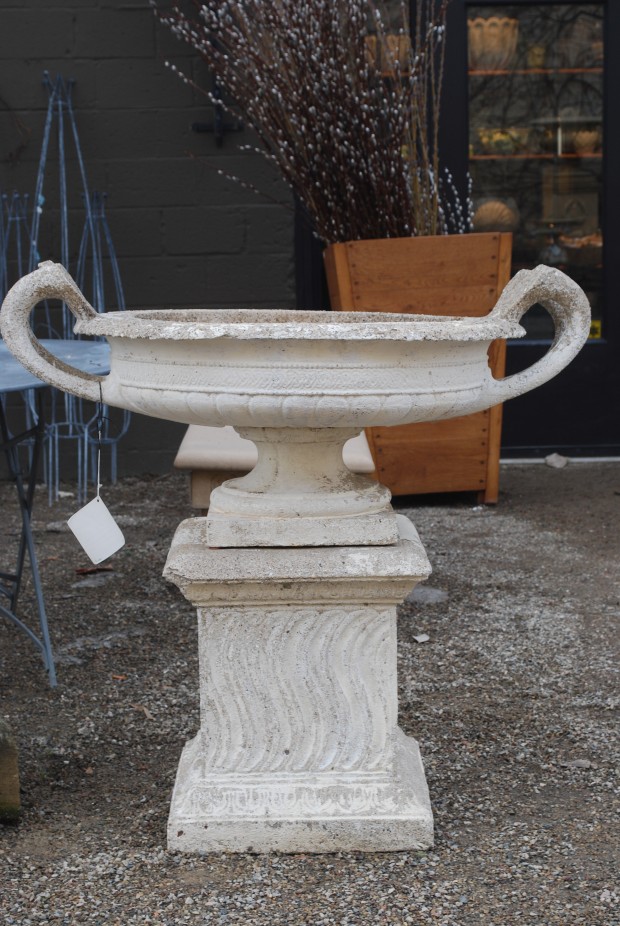 Painted American concrete urn circa 1890
Painted American concrete urn circa 1890
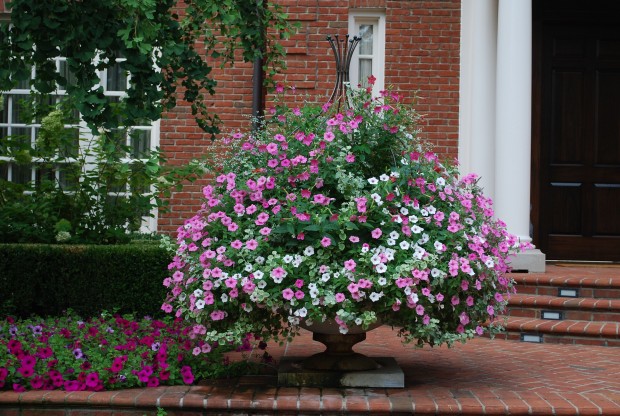 Imagine the planting in this urn, without the foot. The petunias dragging on the ground would not be such a great look. This modest foot helps this summer container shine.
Imagine the planting in this urn, without the foot. The petunias dragging on the ground would not be such a great look. This modest foot helps this summer container shine.
